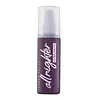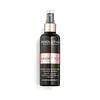What's inside
What's inside
 Key Ingredients
Key Ingredients

 Benefits
Benefits

 Concerns
Concerns

 Ingredients Side-by-side
Ingredients Side-by-side

Water
Skin ConditioningAlcohol Denat.
AntimicrobialKaolin
AbrasivePvp
Emulsion StabilisingDipropylene Glycol
HumectantPhenoxyethanol
PreservativePolyhydroxystearic Acid
EmulsifyingCaprylyl Glycol
EmollientDimethicone PEG-7 Phosphate
CleansingIsononyl Isononanoate
EmollientEthylhexyl Isononanoate
EmollientMethyl Methacrylate Crosspolymer
Sodium Cocamidopropyl Pg-Dimonium Chloride Phosphate
CleansingGlycereth-5 Lactate
EmollientPPG-3 Benzyl Ether Myristate
EmollientPhenylpropanol
MaskingPropanediol
SolventMethyl Diisopropyl Propionamide
MaskingSodium Hydroxide
BufferingAloe Barbadensis Leaf Juice Powder
Skin ConditioningMaltodextrin
AbsorbentPoloxamer 407
EmulsifyingTocopherol
AntioxidantPotassium Sorbate
PreservativeSodium Benzoate
MaskingPentaerythrityl Tetra-Di-T-Butyl Hydroxyhydrocinnamate
AntioxidantParfum
MaskingWater, Alcohol Denat., Kaolin, Pvp, Dipropylene Glycol, Phenoxyethanol, Polyhydroxystearic Acid, Caprylyl Glycol, Dimethicone PEG-7 Phosphate, Isononyl Isononanoate, Ethylhexyl Isononanoate, Methyl Methacrylate Crosspolymer, Sodium Cocamidopropyl Pg-Dimonium Chloride Phosphate, Glycereth-5 Lactate, PPG-3 Benzyl Ether Myristate, Phenylpropanol, Propanediol, Methyl Diisopropyl Propionamide, Sodium Hydroxide, Aloe Barbadensis Leaf Juice Powder, Maltodextrin, Poloxamer 407, Tocopherol, Potassium Sorbate, Sodium Benzoate, Pentaerythrityl Tetra-Di-T-Butyl Hydroxyhydrocinnamate, Parfum
Water
Skin ConditioningAlcohol Denat.
AntimicrobialPropylene Glycol
HumectantAmp-Acrylates/Allyl Methacrylate Copolymer
Benzyl Alcohol
PerfumingDehydroacetic Acid
PreservativePEG-40 Hydrogenated Castor Oil
EmulsifyingTocopheryl Acetate
AntioxidantAloe Barbadensis Leaf Juice
Skin ConditioningHelianthus Annuus Seed Oil
EmollientPanthenol
Skin ConditioningRetinyl Palmitate
Skin ConditioningLinseed Acid
CleansingSorbitol
HumectantAesculus Hippocastanum Seed Extract
Skin ConditioningSodium Benzoate
MaskingBHT
AntioxidantWater, Alcohol Denat., Propylene Glycol, Amp-Acrylates/Allyl Methacrylate Copolymer, Benzyl Alcohol, Dehydroacetic Acid, PEG-40 Hydrogenated Castor Oil, Tocopheryl Acetate, Aloe Barbadensis Leaf Juice, Helianthus Annuus Seed Oil, Panthenol, Retinyl Palmitate, Linseed Acid, Sorbitol, Aesculus Hippocastanum Seed Extract, Sodium Benzoate, BHT
Ingredients Explained
These ingredients are found in both products.
Ingredients higher up in an ingredient list are typically present in a larger amount.
Alcohol Denat. is an alcohol with a denaturant property. It is created by mixing ethanol with other additives.
This ingredient gets a bad rep because it is irritating and drying - mostly due to its astringent property. Astringents draw out natural oils in tissue, constricting pores and leaving your skin dried out.
However, alcohol denat. is not all that bad.
Due to its low molecular weight, alcohol denat. tends to evaporate quickly. One study on pig skin found half of applied alcohol evaporated in 10 seconds and less than 3% stayed on skin.
This also helps other ingredients become better absorbed upon application.
Studies are conflicted about whether this ingredient causes skin dehydration. One study from 2005 found adding emollients to propanol-based sanitizer decreased skin dryness and irritation. Another study found irritation only occurs if your skin is already damaged.
Small amounts of alcohol are generally tolerated by oily skin or people who live in humid environments.
The rule of thumb is if this alcohol is near the end of an ingredients list, it will probably not affect your skin much.
Also...
This ingredient has antimicrobial and solvent properties.
The antimicrobial property helps preserve products and increase their shelf life. As a solvent, it helps dissolve other ingredients.
Other types of astringent alcohols include:
Learn more about Alcohol Denat.Sodium Benzoate is a preservative. It's used in both cosmetic and food products to inhibit the growth of mold and bacteria. It is typically produced synthetically.
Both the US FDA and EU Health Committee have approved the use of sodium benzoate. In the US, levels of 0.1% (of the total product) are allowed.
Sodium benzoate works as a preservative by inhibiting the growth of bacteria inside of cells. It prevents the cell from fermenting a type of sugar using an enzyme called phosphofructokinase.
It is the salt of benzoic acid. Foods containing sodium benzoate include soda, salad dressings, condiments, fruit juices, wines, and snack foods.
Studies for using ascorbic acid and sodium benzoate in cosmetics are lacking, especially in skincare routines with multiple steps.
We always recommend speaking with a professional, such as a dermatologist, if you have any concerns.
Learn more about Sodium BenzoateWater. It's the most common cosmetic ingredient of all. You'll usually see it at the top of ingredient lists, meaning that it makes up the largest part of the product.
So why is it so popular? Water most often acts as a solvent - this means that it helps dissolve other ingredients into the formulation.
You'll also recognize water as that liquid we all need to stay alive. If you see this, drink a glass of water. Stay hydrated!
Learn more about Water